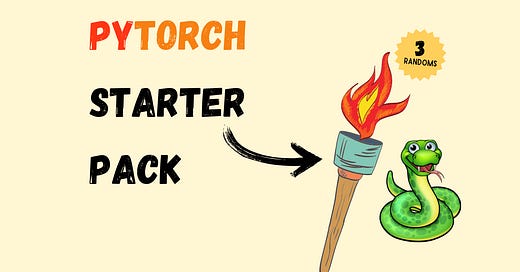PyTorch Simplified: Essential Code Snippets Every AI Enthusiast Needs to Know
Get Started with PyTorch now and learn tensors, neural networks, model training, and optimization for efficient AI development!
PyTorch has quickly become a top choice for machine learning and deep learning, and there’s a good reason for that. It’s an open-source Python library that makes training models easier, faster, and more intuitive.
I’ve tried several deep learning libraries, but PyTorch is slowly clicking with me. It’s like working with Python itself—clean, logical, and designed so you can focus on solving problems, not dealing with complicated code. Cough, cough, I’m looking at you Tensorflow.
Welcome to PyTorch. Check out other 3 Random Articles here.
Imagine you're subscribed to a newsletter called 3 Randoms. Each week, it introduces you to three lesser-known Python tools that can make your coding better. It's like expanding your toolbox and discovering new tricks.
Maybe you’re just starting to experiment with neural networks or you're working on advanced models, PyTorch has the tools to make everything simpler. It has a dynamic computation graph, easy-ish syntax, and smooth GPU support, which makes it stand out from its competitors.
PyTorch gives you a simple way to build everything from basic models to complex systems. With built-in functions for tensors, automatic differentiation, and datasets, it makes getting into machine learning much less intimidating. Plus, it handles large computations easily, which is a big win.
I can safely say I am not an expert in this but that I am consistently learning more everyday. That’s really what being a developer is, it’s not just a developer for code but also self development.
Today, I’ll show you how to set up PyTorch, create a basic model, and understand the core elements of this powerful tool.
Guys this really only scratches the surface, as we wind up our SQL in Python series I am eying a new series that will build on everything we have been covering the last few months with a clear progression towards Machine and Deep Learning.
I’m excited to share what I’ve learned and dive deeper into PyTorch in future projects and articles. Today’s code examples will give you a solid foundation to start building and experimenting.
Currently we are in our SQL in Python series, but soon I will be releasing a longer series dedicated to the Big 3: Big Data Analytics, Machine Learning & Deep Learning.
This is just a tease and you will get into it all soon!
If you haven’t subscribed to my premium content yet, I highly encourage you to do so. My premium readers get full access to these articles and all the code that comes with them, so you can follow along!
Plus, you’ll get access to so much more, like monthly Python projects, in-depth weekly articles, this here '3 Randoms' series, and my complete archive!
👉 If you get value from this article, please leave it a ❤️. This helps more people discover this newsletter, which helps me out immensely!
Let’s kick things off by installing PyTorch.
pip3 install torch torchvision torchaudioOnce you’ve got it set up, you’re ready to dive into the world of deep learning.
This Week’s PyTorch Tips
Keep reading with a 7-day free trial
Subscribe to The Nerd Nook to keep reading this post and get 7 days of free access to the full post archives.





